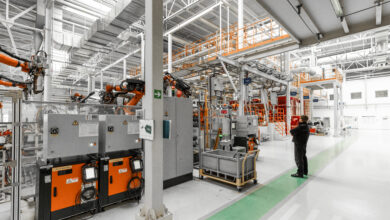Difference Between Enterprise vs. Standard App Development
This blog illustrates the differences between the two types of app development. Get to know more!
Enterprise apps are designed for large organizations, while standard apps are designed for individuals or small-scale users. They are designed to support a company’s core processes and business goals. They need to be reliable, secure, and scalable, while also being easy to use. This way Enterprise applications streamline the processes and improve efficiency, decision making, collaboration, and communication.
Features of Enterprise Apps
Enterprise apps are often more complex than standard apps and have different capabilities:
- Purpose: Enterprise apps are designed to meet the needs of large organizations, while standard apps are designed for individuals or small-scale users.
- Functionality: Enterprise apps are designed for specific industries, while standard apps are lifestyle driven.
- Integration: Enterprise apps integrate with existing systems like databases or CRM tools to keep data up to date.
- User management: Enterprise apps have user access control that allows administrators to control who sees what.
- Scalability: Enterprise apps need to be able to handle growth in services, number of people, and more.
- Internal architecture: Enterprise apps are designed for multiple users performing different functions simultaneously, so their software architecture needs to be built for speed, scalability, and multiple data flows.
Types of Enterprise Applications
Enterprise applications (software) improves business performance by fulfilling their software needs. Examples of types of enterprise applications:
- Human resource management (HRM): Automates HR processes like employee onboarding, payroll, and performance management
- Business intelligence (BI): Combines data from multiple sources for analysis and reporting
- Enterprise resource planning (ERP): A type of enterprise application to fulfill an organization’s software needs
- Supply chain management (SCM): To streamline business’ supply chain from suppliers to customers
- Customer relationship management (CRM): Apps to manage customer relationships
- Project management: To facilitate effective collaboration by tracking project progress, milestones, and tasks
- Content management: To ease the burden of the businesses to manage, store, and share media types through multiple channels
- Accounting: Tracks an organization’s finances and automates tasks like billing, account reconciliation, and vendor payments
What are Standard application?
It makes use of third-party, subscription-based applications, while custom app development is based on a specific client or business’s needs. Custom apps are designed from scratch or extensively customized to meet the unique requirements of a business or organization. It includes application functionality that is available out-of-the-box, along with configurable options in the system. Standard applications differ from custom applications in various different ways:
- Customization: Custom apps are highly customizable and user-centric, while standard apps have limited customization options.
- Ownership: Custom apps give the organization full ownership, while standard apps give the app creators ownership.
- Scalability: Custom apps adapt to changing workflows and handle large volumes of data, while standard apps may not align with specific business needs.
- Maintenance: Custom apps are easy to maintain and give the organization complete control over the maintenance process.
Types of applications (standard) that cannot be considered as Enterprise Applications
- General applications: These include word processing, spreadsheet, presentation, graphics, web browsers, multimedia, education and reference, and simulation software
- Scientific software: Usable for scientific work, such as Matlab and Similink
- Realtime software: These make washing machines and airplanes work
- Mobile apps: Such apps make mobile phone work. E.g: document readers and galleries
- Networking software: These facilitate communication, such as Whatsapp
- Web-based applications: These include websites and web-based programs, such as online banking and railway sites
- Database software: These manage large data storages, such as Oracle and DB2
Differences: Enterprise App Development vs. Standard App Development
Enterprise applications are designed for businesses and their employees to handle complex business processes, while standard applications are designed for general needs. Standard app development is for individual or small-scale users, while enterprise app development is for large organizations. Enterprise app development creates custom software for businesses to address their specific needs. Standard app development, on the other hand, provides general solutions that fit a wider range of needs. The differences are as follows:
- Functionality: Enterprise apps are designed for specific industries and handle complex business processes. Standard apps are lifestyle-driven and simpler (fit general needs).
- Customizing app features: Enterprise apps are tailor-made to meet a company’s unique needs. Standard apps offer general solutions.
- Deploying the project: Enterprise apps are not downloaded from app stores but deployed to necessary platforms and devices.
- Scaling it up: Enterprise apps are open to scale up or down to meet an organization’s specific needs.
- Development process: Enterprise app development is complex and time-consuming. Standard app development may be quicker and less complex.
- Scalability: Enterprise apps need to handle growth in services and number of users.
- Complexity: Enterprise apps are more complex and require a more comprehensive development process. They need to support a large number of users, high traffic levels, and compliance standards.
- Integration: Enterprise apps should sync seamlessly with existing systems.
- User Management: Enterprise apps have user access control, allowing administrators to control who sees what.
- Development cost: Enterprise apps are more expensive than consumer apps because they require more planning and testing.
- Security: Enterprise apps have enhanced security features like two-factor authentication and data encryption to protect sensitive information.
A Little Bit About Custom Software Development
Custom application development is similar to enterprise application development in that both are tailored to meet specific business needs. However, standard app development is designed for individual tasks or users. The size of the app/software is not defined here, because they are big or medium sized based on the features and functionality to be included.
Renditioning the App Development Cost
At the time of agile software development, it is not assumed in advance that it will be a very large project or this project requires minimal effort. Although a budget is allocated in advance, but the flexibility to accommodate is always there. Considering India, the app development cost ranges from $2.5 lakhs to $20 lakhs (based on features, functionality, timeline, developer demographics, expertise, technologies in demand, security updates, deployment and maintenance charges, legal hurdles, app store/play store policies) etc. The complexity of the app is one of the most important factors that affects the final cost of development.
Besides this, it is very important to consider:
|
|
In 2024, the cost to develop an app in the US range from $10,000 to $300,000, depending on the app’s complexity:
- Simple apps: $10,000–$15,000
- Mid-size apps: $20,000–$30,000
- Large-size apps: $40,000–$50,000
- Complex apps: $75,000–$90,000
- Enterprise-level apps: $90,000+
(All figures are fictitious, final cost can vary)
Important Considerations While Choosing an App Development Tool
When choosing app development tools consider:
- Whether the tool is within your budget
- Whether the tool offers a codeless experience, minimal coding, or requires users to write code
- Whether the tool can meet your organizational requirements
- Whether the tool provides sufficient support for all the device types you’ll deploy the app to
E.g: App development tools for use by an enterprise application development company include Xamarin, Ionic, and Flutter
Some examples of App development tools used by any standard application development company include Android Studio, React Native, Xcode, and AppCode.
A Quick Recap
| Custom Applications | Enterprise Applications | Standard Applications |
| Custom applications are designed and deployed for specific users to fulfill business requirements. Custom apps are built from scratch or extensively customized to align with the unique workflows, processes, and objectives of the organization. | Enterprise applications are built and deployed applications customized to complex business requirements. Enterprise applications are designed for the needs of an entire organization and handle complex, multifaceted tasks such as ERP or CRM. | Standard apps are typically designed for individual tasks or users. Standard software caters to a broader range of users. |
| Development Process: Custom and enterprise application development involves close collaboration between business stakeholders and the app development team. | ||
| Scalability: Enterprise applications may need to be able to scale up or down to fit the specific needs of an organization. | ||
| Cost: Small custom apps tend to run between $10,000-$15,000, while medium-sized apps are around the $20,000-$30,000 mark. Large and enterprise-grade applications typically cost more than $90,000. | ||



